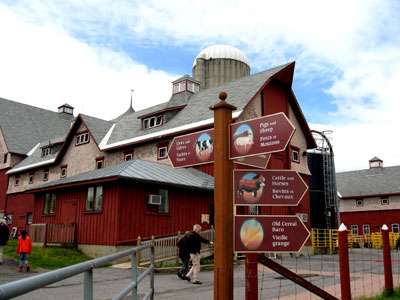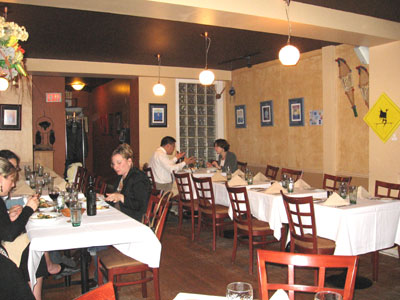After my very interesting introduction to sheep shearing and all sorts of wool processing techniques I had a chance to link up with David Sutin who is the Communications, Marketing and Farm Operations Manager for the Canada Agriculture Museum. In fact, Ottawa is the only world capital that has a working farm at its heart. David volunteered to give me a personal tour through the various facilities of the Museum and we started with the Dairy Barn. Right when you come in is an area for the “dry cows”: these are pregnant animals that stop giving milk in the two months before giving birth. David explained to me that the gestation period of cows is very similar to that of humans: 9 months.

Yes, definitely the Dairy Cow Barn…
David elaborated that male calves get moved into the sale barn and sadly enough, eventually they end up being processed into veal. On the other hand, the Museum keeps the female calves so they can grow up into milk cows. The Canada Agriculture Museum is home to a variety of different dairy cattle breeds and the most productive of them all are Holsteins. Jersey cows were imported from islands in the British Channel and I was just amazed at the beautiful faces and the huge, long-lashed eyes of these cows. The Canadienne cows were brought over from Europe by immigrants from France since they are hardier and better able to withstand the harsh Canadian winters although they are not highly efficient milk producers.
Every day the herdspersons at the Museum milk the cows at 6 am and 3:45 pm. The electric milking machines are connected to an overhead pipe system that leads into a 2500 liter storage tank where all the milk from the cows is collected and cooled to a temperature of 0 to 5 degrees Celsius. The milk is agitated for even cooling. Each cow actually drinks a bathtub of water everyday and produces 30 liters of milk. The milk of the cows is picked up every couple of days by the milk truck. David explained when a cow is sick and receiving antibiotic treatment, the milk is not allowed to be collected and actually gets washed down the drain.

The beauty with the huge eyes…
We then continued into the maternity area that is also used for isolating sick animals. David mentioned that occasionally cows will suffer from a “twisted flipped stomach” (a cow’s stomach actually consists of 4 separate parts) and this condition requires surgery. The veterinarian opens the cow’s side with a 30 cm cut, manually twists the stomach back to the correct position and sews it onto to the abdomen wall. The whole procedure doesn’t take much more than an hour and is performed right in the barn, definitely not under sterile conditions. But the animals always seem to come out okay.
The cow barn is not air conditioned and in the summer it gets pretty warm in the building. At night the cows are taken across the property to a night pasture where they are allowed to graze the whole night and they are taken back into the barn by 6 am. Year round the cows are fed “corn silage” which is made of ground up corn plants, stalks and all. The entire milk production is a big revenue producer for the Museum and offsets some of the operating costs.

The Canada Agriculture Museum
From the Dairy Barn we went into an exhibition area that featured a variety of samples of historic farm machinery. The “Beck Circus”, dating back to 1912, was a piece of demonstration equipment that was used to show how electricity could make a farmer’s life easier. The Hydro-Electric Power Commission came up with this contraption to show farmers the operation of a variety of electrically powered devices, e.g. vacuum pumps for milking machines, a rocker churn to make butter, a feed grinder, a windmill pump and an electrical washing machine. These were the early days of electrical power when most farm work was still done completely manually, only assisted with the help of farm animals. It’s hard to imagine how the quality of life of farmers must have improved with the advent of electric power.

The Beck Circus




